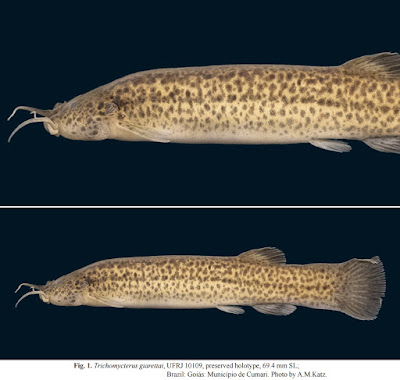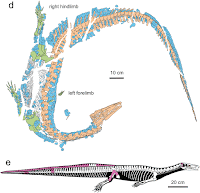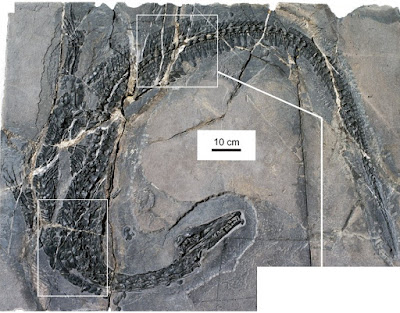[Most Recent Entries] [Calendar View]
Sunday, December 11th, 2016
| Time | Event | ||
| 9:13a | [Ichthyology • 2016] Moenkhausia parecis • A New Species of Moenkhausia Eigenmann (Characiformes: Characidae) from the upper rio Machado at Chapada dos Parecis, rio Madeira Basin, Brazil
ABSTRACT A new species of Moenkhausia is described from the upper rio Machado at Chapada dos Parecis, rio Madeira basin, Rondônia State, Brazil. Among congeners, the new species is similar to Moenkhausia chlorophthalma, M. cotinho , M. lineomaculata , M. plumbea, and M. petymbuaba by having dark blotches on the anterior portion of the body scales, which are absent in the remaining species of the genus. The new species differs from aforementioned species by possessing blue eyes in life, 15-18 branched anal-fin rays, and a well-defined, round caudal-peduncle spot that does not reach the upper and lower margins of the caudal peduncle and does not extend to the tip of the middle caudal-fin rays. Key words: Amazon basin; Fish; Moenkhausia cotinho; Ostariophysi; Taxonomy Diagnosis. Moenkhausia parecis is distinguished from all congeners, except M. clorophthalma Sousa, Netto-Ferreira & Birindelli, 2010, some populations of M. cotinho Eigenmann, 1908(see Discussion), M. lineomaculata [Dagosta, Marinho & Benine, 2015], M. petymbuaba [Lima & Birindelli, 2009], and M. plumbea [Sousa, Netto-Ferreira & Birindelli, 2010] by the presence of a dark blotch on the anterior portion of each scale of the second to seventh longitudinal series (vs. pigmentation absent or, when present, concentrated at the posterior margin of scales, forming a reticulate pattern). Moenkhausia parecis can be readily distinguished from all aforementioned species by having completely blue eyes in life (vs. green in M. clorophthalma, mostly green with some red in M. petymbuaba, lower portion blue and upper portion orange in M. lineomaculata, clear or red in M. cotinho, and clear, with a longitudinal dark stripe in M. plumbea). Additionally, it is distinguished from M. clorophthalma, M. petymbuaba and M. plumbea by having 15-18 (rarely 18) branched anal-fin rays (vs. 18-24), from M. cotinho and M. lineomaculata by having a smaller caudal-peduncle spot, with only the base of the middle caudal-fin rays pigmented (vs. blotch larger, base of all caudal-fin rays pigmented in M. cotinho and M. lineomaculata, except the outermost unbranched rays in some specimens of M. lineomaculata) and by the absence of a light area preceding caudal-peduncle spot (vs . presence of a light area preceding caudal-peduncle spot). It can be further distinguished from M. clorophthalma, M. plumbea and M. plumbea by having a well-defined, round caudal-peduncle spot, that does not extend to the tip of the middle caudal-fin rays (vs . caudal-peduncle spot absent or poorly defined in M. clorophthalma and M. plumbea or caudal-peduncle spot confluent with longitudinal stripe on body, reaching the tip of middle caudal-fin rays in M. plumbea). Etymology. The specific name parecis refers to the Chapada dos Parecis (plateau including the type locality), an important watershed that separates tributaries of three basins: rio Madeira, rio Tapajós and rio Paraguai. A noun in apposition. Distribution. Moenkhausia parecis is known only from its type locality, a headwater tributary of igarapé Piracolina, itself a tributary of the upper rio Machado at Chapada dos Parecis, rio Madeira basin, about 9 km south of Vilhena, near the border of Rondônia and Mato Grosso States, Brazil (Fig. 3). Moenkhausia parecis is possibly an additional species endemic to the rivers draining the Chapada dos Parecis(see list in Ohara & Lima, 2015). Ecological notes. The type locality of Moenkhausia parecis is located at 585 m above sea level on the Chapada dos Parecis. It is a small "terra-firme igarapé" (= highland creek) with little preserved riparian vegetation and surrounded by large plantation fields (mostly soy and corn), near Vilhena, Mato Grosso. It is a clear water stream 1.5-2.5 m wide and 0.3-0.8 m deep, with swift currents, and a bottom composed of sand and dead leaves (Fig. 4). During snorkeling, Moenkhausia parecis was observed in small groups of 10-15 individuals swimming in midwater. Syntopic species included Ancistrus verecundus Fisch-Muller, Cardoso, da Silva & Bertaco, 2005, Bryconops piracolina Wingert & Malabarba, 2011, Cetopsorhamdia sp. 3 (cf. Bockmann & Slobodian, 2013: 25), Corydoras sp., Hyphessobrycon lucenorum Ohara & Lima, 2015, Hyphessobrycon aff. melonostichos Carvalho & Bertaco, 2006 and Pyrrhulina sp. The stomach contents of the four (c&s) paratypes included ants, scales, unidentified insect fragments, seeds, unidentified vegetal fragments and sediments. Conservation status. Despite intensive and broad collecting efforts in the rio Madeira basin during 2009 to 2013 (Queiroz et al., 2013) and recent surveys conducted in the southeastern portion of Rondônia State and northwest of Mato Grosso State undertaken in 2010-2011 and 2013-2014, Moenkhausia parecis was only collected at its type locality. Additionally, examination of several fish collections failed to reveal additional specimens. Thus, it is possible that the species is restricted to the upper rio Machado, at the Chapada dos Parecis. The type locality of M. parecis is a small forest fragment near Vilhena town that is surrounded by farms. According to the International Union for Conservation of Nature (IUCN) categories and criteria (IUCN Standards and Petitions Subcommittee, 2014), Moenkhausia parecis might be considered as 'Vulnerable (D2)', based on its occupation area (AOO) apparently less than 20 km2 and the plausible future threat (agricultural development and expansion of Vilhena town around its very restricted distribution) that could lead the species to become critically endangered or extinct. Willian M. Ohara and Manoela M F Marinho. 2016. A New Species of Moenkhausia Eigenmann (Characiformes: Characidae) from the upper rio Machado at Chapada dos Parecis, rio Madeira Basin, Brazil. Neotropical Ichthyology [Neotrop. ichthyol.]. 14(1); DOI: 10.1590/1982-0224-20150041 RESUMO: Uma espécie nova de Moenkhausia é descrita do alto rio Machado na Chapada dos Parecis, bacia do rio Madeira, Rondônia, Brasil. Entre as congêneres, a espécie nova é semelhante à Moenkhausia chlorophthalma , M. cotinho , M. lineomaculata , M. plumbea e M. petymbuaba por ter manchas escuras na região anterior das escamas, que estão ausentes nas demais espécies do gênero. A espécie nova difere das espécies mencionadas acima por possuir olhos azuis em vida, 15-18 raios ramificados na nadadeira anal e uma mancha arredondada bem definida no pedúnculo caudal, que não alcança o limite superior e inferior do pedúnculo caudal, e não se estende sobre os raios medianos da nadadeira caudal. | ||
| 10:13a | [Ecology / Paleontology • 2016] Patterns, Causes, and Consequences of Anthropocene Defaunation ABSTRACT Anthropocene defaunation, the global extinction of faunal species and populations and the decline in abundance of individuals within populations, has been predominantly documented in terrestrial ecosystems, but indicators suggest defaunation has been more severe in freshwater ecosystems. Marine defaunation is in a more incipient stage, yet pronounced effects are already apparent and its rapid acceleration seems likely. Defaunation now impacts the planet's wildlife with profound cascading consequences, ranging from local to global coextinctions of interacting species to the loss of ecological services critical for humanity. Slowing defaunation will require aggressively reducing animal overexploitation and habitat destruction; mitigating climate disruption; and stabilizing the impacts of human population growth and uneven resource consumption. Given its omnipresence, defaunation should receive status of major global environmental change and should be addressed with the same urgency as deforestation, pollution, and climatic change. Global action is needed to prevent defaunation's current trajectory from catalyzing the planet's sixth major extinction. Keywords: animal conservation, defaunation cascades, animal overexploitation, terrestrial fauna, marine fauna, freshwater fauna Hillary S. Young, Douglas J. McCauley, Mauro Galetti and Rodolfo Dirzo. 2016. Patterns, Causes, and Consequences of Anthropocene Defaunation. Annual Review of Ecology, Evolution, and Systematics. 47; 333-358. DOI: 10.1146/annurev-ecolsys-112414-054142 | ||
| 10:34a | [Botany • 2015] Argyreia albiflora | เครือพิสุทธิ์ • A New Species (Convolvulaceae) from Chiang Mai, northern Thailand
Abstract A new species of Argyreia (Convolvulaceae) from Thailand is described and illustrated: Argyreia albiflora. The morphological distinctions of this new species and its relationships with allied species are discussed. Micromorphological evidence is presented using scanning electron microscopy (SEM) and light microscopy (LM) demonstrating that microscopic features of the upper leaf surface are useful in separating species that are similar on a macromorphological level. Keywords: Argyreia albiflora, Argyreia wallichii, cutin, leaf anatomy, leaf epidermis George W. Staples. Paweena Traiperm and Janeny Chow. 2015. Another New Thai Argyreia Species (Convolvulaceae). Phytotaxa. 204(3). DOI: 10.11646/phytotaxa.204.3.5 เครือพิสุทธิ์ พืชวงศ์ผักบุ้งชนิดใหม่ของโลก | ||
| 12:15p | [Ichthyology • 2016] Trichomycterus giarettai • A New Species of the Catfish Genus Trichomycterus (Siluriformes: Trichomycteridae) from the Paranaíba Basin, Central Brazil Abstract Trichomycterus giarettai, new species, from a small river in Cumari municipality, Central Brazil is described. It is hypothesized to be closely related to species of T. brasiliensis complex by possessing the opercular odontodes disposed obliquely on the patch. Trichomycterus giarettai is diagnosed by the distribution of infraorbital pores, body width, caudal peduncle width, number of vertebrae, branchiostegal rays, dorsal and ventral procurrent rays, opercular and interopercular odontodes, length of the nasal barbels, and pelvic fin insertion. Key words: Catfishes, Goiás, Neotropical, Trichomycterinae, systematics, taxonomy.
Distribution. Known only from a small stream, tributary of the upper rio Paranaíba basin, Central Brazil. Etymology. The name “giarettai” was given in honor to the herpetologist A. Giaretta, that first collected the new species in the field. M. A. Barbosa and A. M. Katz. 2016. A New Species of the Catfish Genus Trichomycterus (Teleostei: Siluriformes: Trichomycteridae) from the Paranaíba Basin, Central Brazil. Vertebrate Zoology. 66(3); 261-265. Resumo: Trichomycterus giarettai, espécie nova, de um pequeno riacho no município de Cumari, Brasil Central, é descrito. Ele é hipotetizado como proximamente relacionado as espécies do complexo T. brasiliensis por possuir a distribuição diagonal dos odontódeos na placa opercular. Trichomycterus giarettai é diagnosticado pela distribuição dos poros infraorbitais, largura do corpo, largura do pedúnculo caudal, número de vértebras, raios branquiostegais, raios procorrentes ventrais e dorsais,odontódeos operculares e interoperculares, comprimento dos barbilhões nasais e inserção da nadadeira pélvica. | ||
| 12:38p | [Paleontology • 2016] Litorosuchus somnii • A New Armored Archosauriform (Diapsida: Archosauromorpha) from the Marine Middle Triassic of China, with Implications for the Diverse Life Styles of Archosauriforms Prior to the Diversification of Archosauria
Abstract Reptiles have a long history of transitioning from terrestrial to semi-aquatic or aquatic environments that stretches back at least 250 million years. Within Archosauria, both living crocodylians and birds have semi-aquatic members. Closer to the root of Archosauria and within the closest relatives of the clade, there is a growing body of evidence that early members of those clades had a semi-aquatic lifestyle. However, the morphological adaptations to a semi-aquatic environment remain equivocal in most cases. Here, we introduce a new Middle Triassic (245–235 Ma) archosauriform, Litorosuchus somnii, gen. et sp. nov., based on a nearly complete skeleton from the Zhuganpo Member (Ladinian [241–235 Ma]) of the Falang Formation, Yunnan, China. Our phylogenetic analyses suggest that Litorosuchus is a stem archosaur closely related to the aberrant Vancleavea just outside of Archosauria. The well-preserved skeleton of L. somnii bears a number of morphological characters consistent with other aquatic-adapted tetrapods including: a dorsally directed external naris, tall neural spines and elongate chevrons in an elongated tail, a short and broad scapula, webbed feet, long cervical vertebrae with long slender ribs, and an elongated rostrum with long and pointed teeth. Together these features represent one of the best-supported cases of a semi-aquatic mode of life for a stem archosaur. Together with Vancleavea campi, the discovery of L. somnii demonstrates a growing body of evidence that there was much more diversity in mode of life outside Archosauria. Furthermore, L. somnii helps interpret other possible character states consistent with a semi-aquatic mode of life for archosauriforms, including archosaurs. Keywords: Adaptation; Morphology; Phylogeny; Reptile; Semi-aquatic Systematic paleontology Diapsida (Osborn 1903). Archosauromorpha (von Huene 1946) sensu (Benton 1985). Archosauriformes (Gauthier et al. 1988). Litorosuchus somnii gen. et sp. nov. Etymology: From Latin litoralis, indicating the coastal region where the archosauriform may have lived and Greek soukhos crocodile. From Latin somnium —“dream” in reference to a dream the first author (Li) had the day after he searched for a name for the animal, in which he saw an archosauriform wandering on the beach. Holotype: IVPP V 16978, a nearly complete skull and skeleton embedded in a slab of limestone with much of its right lateral side exposed. Locality and horizon: Jiyangshan, west of Huangnihe River, southeast Fuyuan County, Yunnan Province, China; Zhuganpo Member of the Falang Formation, Late Middle Triassic (Ladinian (241–235 Ma)) (Chen 1985). Diagnosis: A medium-sized reptile (snout to tip of the tail length = ∼2.0 m), differing from other non-archosaur archosauriforms in having the following unique combination of character states: premaxilla bearing only two anteriorly positioned teeth with a short diastema anterior to and a long diastema posterior to the teeth, respectively; posterodorsal (maxillary) process of the premaxilla long and extending just posteriorly; nasal process of the premaxilla extending posteriorly beyond the posterodorsal margin of the external naris; large caniniform tooth in each tooth-bearing bone (shared with V. campi); midline length of the snout (measured from anterior edge of the orbit to the anterior tip of the premaxilla) more than twice that of the post-snout region (shared with species of Chanaresuchus, Q. mixtus, and D. fuyuanensis); T-shaped prefrontal with an elongate and bar-like descending process extending as ventrally as the lacrimal; lacrimal excluded by the prefrontal from the orbit; interfenestral region of the skull roof very narrow, less than one fifth of interorbital width; body completely covered by variously shaped osteoderms in certain regions (e.g., spine-like dorsal osteoderms on caudal vertebrae 10 to 13); tail long, about 60 % of the total length; vertical ridge present on the lateral surface of the neural spine of caudal vertebrae 9 to 35; cervical ribs slender and elongate; astragalus-calcaneum contact a simple butt joint, calcaneal tuber nearly absent. Asterisks denote autapomorphies. Chun Li, Xiao-chun Wu, Li-jun Zhao, Sterling J. Nesbitt, Michelle R. Stocker and Li-Ting Wang. 2016. A New Armored Archosauriform (Diapsida: Archosauromorpha) from the Marine Middle Triassic of China, with Implications for the Diverse Life Styles of Archosauriforms Prior to the Diversification of Archosauria. The Science of Nature [Naturwissenschaften]. 103: 95. DOI: 10.1007/s00114-016-1418-4Paleo Profile: The Dream Coast Crocodile https://blogs.scientificamerican.com/lae |
| << Previous Day |
2016/12/11 [Calendar] |
Next Day >> |





















